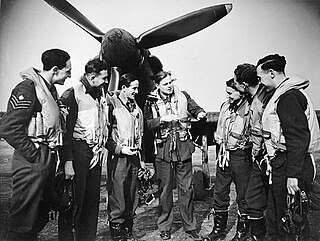No. 118 Squadron was a squadron of the British Royal Air Force. Originally formed in 1918, it served as a fighter squadron in the Second World War, flying Spitfires and Mustangs. It flew jet fighters as part of RAF Germany in the 1950s, and Bristol Sycamore helicopters in Northern Ireland before finally disbanding in 1962.

The Type Two HSL was a 63 ft high-speed launch craft made by British Power Boat Company (BPBC). The craft were used during the Second World War for air-sea rescue operations to save Allied aircrew from the sea. The Type Two superseded the 64 ft HSL, and was itself replaced by the Type Three 68 ft "Hants and Dorset" also built by the BPBC. The Type Two was nicknamed the "Whaleback" due to the distinctive curve to its deck and humped cabin.

Brighton City Airport, also commonly known as Shoreham Airport, is located in the Shoreham by Sea in West Sussex, England. It has a CAA Public Use Aerodrome Licence that allows flights for the public transport of passengers or for flying instruction.

No. 313 Squadron RAF was a Czechoslovak-manned fighter squadron of the Royal Air Force in the Second World War.
Royal Air Force Montrose or more simply RAF Montrose is a former Royal Air Force station in Forfarshire in Scotland. It became the first operational military aerodrome to be established in the United Kingdom on 26 February 1913.

No. 609 Squadron of the Royal Auxiliary Air Force, originally formed as a bomber squadron and in the Second World War active as fighter squadron, nowadays provides personnel to augment and support the operations of the Royal Air Force. The squadron is no longer a flying squadron, but instead has the role of Force Protection. It is currently based at RAF Leeming, North Yorkshire.
No. 282 Squadron was a Royal Air Force air-sea rescue squadron during the Second World War.
No. 283 Squadron was a Royal Air Force squadron that served during the Second World War in the air-sea rescue (ASR) mission role while flying Supermarine Walruses and both in ASR and the anti-submarine patrol role while flying Vickers Warwicks.
No. 284 Squadron was a Royal Air Force squadron.

Royal Air Force Fairwood Common, or more simply RAF Fairwood Common, is a former Royal Air Force sector station located on Fairwood Common, on the Gower Peninsula, to the west of Swansea. It is now the location of Swansea Airport.
No. 203 Squadron RAF was originally formed as No. 3 Squadron Royal Naval Air Service. It was renumbered No. 203 when the Royal Air Force was formed on 1 April 1918.
No. 520 Squadron RAF was a meteorological squadron of the Royal Air Force during the Second World War.
No. 293 Squadron was a Royal Air Force air-sea rescue squadron. During the Second World War the unit operated search and rescue missions for Allied aircraft operating over Italy.
No. 294 Squadron was a Royal Air Force air search and rescue (ASR) squadron active under RAF Middle East Command. During World War II the unit operated rescue missions for Allied aircraft and aircrew over the eastern Mediterranean and later the Persian Gulf and Arabian Sea.

The Royal Air Force Search and Rescue Force was a unit of the Royal Air Force (RAF) which provided around-the-clock aeronautical search and rescue cover in the United Kingdom, Cyprus, and the Falkland Islands, from 1986 until 2016.
No. 292 Squadron RAF was an air-sea rescue (ASR) squadron of the Royal Air Force operating in the Bay of Bengal during the Second World War.

The Marine Branch (1918–1986) was a branch of the Royal Air Force (RAF) which operated watercraft in support of RAF operations. Just days after the creation of the RAF itself, the Marine Craft Section (MCS) was created with the transfer of Royal Naval Air Service (RNAS) vessels and personnel to the new service. Originally tasked with the support of RNAS, and later RAF, seaplanes, Marine Craft Section was to achieve its greatest size during the Second World War, and achieved fame for its role in air-sea rescue operations. After the war MCS was granted full branch status on 11 December 1947; however, post-war the role of the new branch became greatly reduced with the end of the British Empire, the withdrawal of flying boats from service, and the increasing use of helicopters in air-sea rescue. The branch was disestablished on 8 January 1986.

733 Naval Air Squadron was a Fleet Air Arm (FAA) naval air squadron of the United Kingdom’s Royal Navy (RN). It was active between January 1944 and December 1947, entirely in Ceylon, as a Fleet Requirements Unit, based mainly at R.N. Air Section China Bay, which became HMS Bambara, RNAS Trincomalee, China Bay, Ceylon. The squadron initially formed at R.N. Air Section Minneriya, at RAF Minnerya, Ceylon, two weeks after an advance party arrived there, remaining for three months after formation before relocating.

Group Captain Russell Faulkner Aitken was a New Zealand-born officer who served in the Royal Air Force (RAF) during the Second World War. He pioneered the use of amphibious aircraft for rescuing RAF pilots who had been shot down over the English Channel and the North Sea.

Ronald Hamlyn was a British flying ace with the Royal Air Force (RAF) during the Second World War. He was credited with having destroyed at least ten German aircraft.











